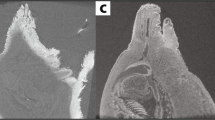Abstract
Morphological lipofuscin concentration in the brains of laboratory-reared crayfish,Cherax quadricarinatus (von Martens), of known age, was quantified using alternative fluorescence microscope and image-analysis techniques. The quantity of olfactory-lobe lipofuscin was highly correlated with age (r=0.96). It was found to be a superior predictor of age compared with the body-size parameters frequently used for this purpose. The results of this study suggest that morphological lipofuscin, quantified by image analysis, has significant potential as a means of age determination for crustaceans.
Similar content being viewed by others
Literature cited
Aloj Totaro, E., Pisanti, F. A., Russo, P., Brunetti, P. (1985). Evaluation of aging parameters inTorpedo marmorata. Annls Soc. r. zool Belg. 115: 203–209
Berman, M. S., McVey, A. L., Ettershank, G. (1989). Age determination of antarctic krill using fluorescence and image analysis of size. Polar Biol. 9: 267–271
Crossland, C. J. (1989). Lipofuscin ageing pigments as a chronological ageing criterion for the western rock lobster: a non-event. Rep. mar. Lab. C.S.I.R.O. Aust. 207: 8–9
Crossland, C. J., Denby, G., Phillips, B. F., Brown, R. (1988). The use of fluorescent pigment (lipofuscin) for ageing western rock lobster (Panulirus cygnus) and scampi (Metanephrops andamanicus): a preliminary assessment. Rep. mar. Lab. C.S.I.R.O. Aust. 195: 1–21
Eldred, G. E. (1987). Questioning the nature of fluorophores in age pigments. Adv. Biosciences 64: 23–36
Ettershank, G. (1983). Age structure and cyclical annual size change in the antarctic krill,Euphausia superba. Polar Biol. 2: 189–193
Ettershank, G. (1985). Population age structure in males and juveniles of the antarctic krill,Euphausia superba. Polar Biol. 4: 199–201
Hirche, H., Anger, K. (1987). The accumulation of age pigments during larval development of the spider crab,Hyas araneus (Decapoda, Majidae) Comp. Biochem. Physiol. 88B(3): 777–782
Katz, M., Robison, W. G., Jr., Herrmann, R. K., Groome, A. B., Bieri, J. G. (1984). Lipofuscin accumulation resulting from senescence and vitamin E deficiency: spectral properties and tissue distribution. Mechanisms Ageing Dev. 25: 149–159
Langley, P. A., Hall, M. J. R., Felton, T., Ceesay, M. (1988). Determining the age of tsetse flies,Glossina spp. (Diptera: Glossinidae): an appraisal of the pteridine fluorescence technique. Bull. ent. Res. 78: 387–395
Lehane, M. J., Chadwick, J., Howe, M. A., Mail, T. S. (1986). Improvements in the pteridine method for determining age in adult male and femaleStomoxys calcitrans (Diptera: Muscidae). J. econ. Ent. 79: 1714–1719
Lehane, M. J., Mail, T. S. (1985). Determining the age of adult male and femaleGlossina morsitans morsitans using a new technique. Ecol. Ent. 10: 219–224
Mail, T. S., Chadwick, J., Lehane, M. J. (1983). Determining the age of adults ofStomoxys calcitrans (Diptera: Muscidae). Bull. ent. Res. 73: 501–525
Nicol, S. (1987). Some limitations on the use of the lipofuscin ageing technique. Mar. Biol. 93: 609–614
Sheehy, M. R. J. (1989). Crustacean brain lipofuscin: an examination of the morphological pigment in the freshwater crayfishCherax cuspidatus (Crustacea: Parastacidae). J. Crustacean Biol. 9: 387–391
Sheehy, M. R. J. (1990a). The widespread occurrence of fluorescent morphological lipofuscin in the crustacean brain. J. Crustacean Biol. 10 (4) (in press)
Sheehy, M. R. J. (1990b). Individual variation in, and the effect of rearing temperature and body size on, the concentration of fluorescent morphological lipofuscin in the brains of freshwater crayfishCherax cuspidatus (Crustacea: Parastacidae). Comp. Biochem. Physiol. (B) 96A: 281–286
Sheehy, M. R. J., Ettershank, G. (1989). Solvent extractable age pigment-like autofluorescence and its relationship to growth and age in the water-fleaDaphnia carinata King. Aust. J. Zool. 36: 611–625
Sohal, R. S. (1981). Metabolic rate, aging, and lipofuscin accumulation. In: Sohal, R. S. (ed.) Age pigments. Elsevier, North Holland, p. 303–316
Sohal, R. S. (1987). Quantification of lipofuscin: a critique of the current methodology. Adv. Biosciences 64: 85–91
Thomas, D. B., Chen, A. C. (1989). Age determination in the adult screwworm (Diptera: Calliphoridae) by pteridine levels. J. econ. Ent. 82: 1140–1144
Author information
Authors and Affiliations
Additional information
Communicated by G. F. Humphrey, Sydney
Rights and permissions
About this article
Cite this article
Sheehy, M.R.J. Potential of morphological lipofuscin age-pigment as an index of crustacean age. Mar. Biol. 107, 439–442 (1990). https://doi.org/10.1007/BF01313426
Accepted:
Issue Date:
DOI: https://doi.org/10.1007/BF01313426




